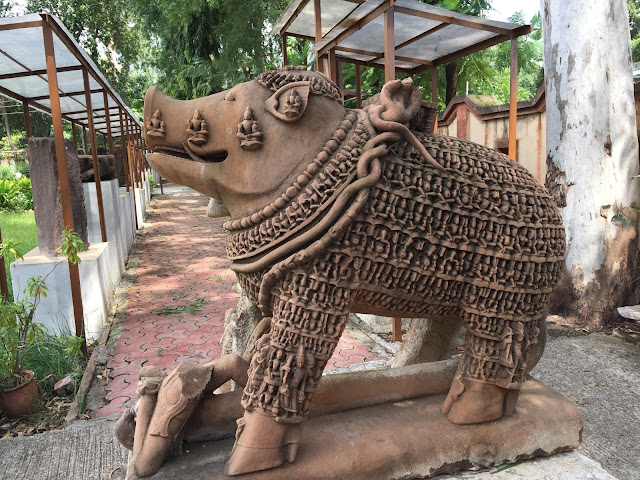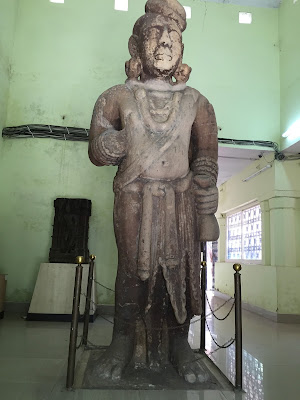 |
| FIELDS |
As
I travel on a train towards my destination Bhopal, I awake early to
see the beautiful sunrise over a strange horizon. These are strange
lands and fields in a continuous stretch of flat land with no hills
in view. It's just a vast expanse of land and water, which are
natures gift, which has not yet been destroyed by the intrusion of
human beings for dwellings.
I
wonder why people from distant lands travelled far and wide. What
made Ashoka choose Sanchi which was then called Kakanaya, to make his world famous Sanchi Stupa? Why
was Vidisha the place where he lived as Governor before he became
Emperor Ashoka? Vidisha is quite far from Pataliputra, to which place
Ashoka belonged. Expansion of Kingdom you would say and I tend to
agree with you. It is all a question of land, the more you have, the
more you want.
 |
| GLORIOUS SANCHI STUPA |
Sanchi
stupa which has stood at its place since 2300 years is a wonderful
structure. How many came and passed this way over the centuries? Did
Akbar, Shah Jehan or Aurangzeb pass by, did Mohd bin Tughlaq stop here on his way
from Delhi to Daulatabad? Shah Jehan on his way to Burhanpur and Aurangzeb on his way to Khuldabad must surely have seen this place. There must have been some who added to the
structure and also those who destroyed in the name of religion.
I
wonder how many men and women would have travelled to this place to see its beauty?
Had it been a teerth sthal(pilgrimage place) hordes of people would travel from far and
wide to wash off their sins. Sanchi at one time may have had the
importance of being a religious place as some Relics of Buddha were embedded
in the stupa here, but now it does not have the importance that
Haridwar or Nashik or Allahabad have. In olden times when travelling
was very difficult people travelling to religious destinations
would wish their families good bye forever, as they often were not
sure if they would return from their pilgrimage. Salvation was also
ensured if one died while on pilgrimage.
As
I pass by Sanchi on the train, I see the stupa on top of a little
hill about ten kilometres from Vidisha, which was the place where Ashoka had spent a
part of his life. His wife belonged to Vidisha. What was life like then, what language did they speak, what food did they eat, was it an amalgamation of sattu from Pataliputra and the staple food of
Vidisha? I really wonder. I wonder about language as it is said that after every few kilometres in India, the dialect or spoken language changes.
As
we approach Bhopal the ugliness of civilisation in the form of hills
of landfill are the first things in view. The vast expanse of
greenery and the soothing fields filled with crops gives way to
buildings.
From
Bhopal we took a cab to visit Sanchi and Vidisha. The stupa at Sanchi
was built over the relics of Gautama the Buddha. This was built in
the 3rd Century BC. When The Buddha died in 483 BC at Kushinara, his
remains were divided amongst seven clans. Almost two hundred years
after Buddha's death, Ashoka took the ashes/relics from some Stupas and
divided them into about 84000 portions and built stupas in different
places all over India. Sanchi stupa was one of these built by Ashoka.
He chose Sanchi as it was close to Vidisha which was the place from
where he had chosen his first wife called Devi. Ashoka had also lived
in these areas as Governor while his father Bindusara was the ruler of Magadh. The stupa that Ashoka built here was originally a low structure of brick and was half the diameter of the present stupa. During the rule of the Sungas, the stupa was enlarged and faced with stone and the balustrade was made.
 |
| Add caption |
The
Stupa is built over a small hill and can therefore be seen from a
distance. There are four gates or Toranas facing the four directions.
 |
| ELEPHANTS AT BASE |
These gates or toranas were made by the Satvahanas in the 1st century AD.
 |
| DWARFS AT BASE |
Two
of the Toranas or gates have elephants at the base of the three masts
on the top. One gate has four lions and the fourth gate has dwarfs at
the base.
 |
| LIONS AT BASE |
The different stories from the life and times of Buddha
have been depicted on the pillars and mast of the gate. Not an inch of space has been left on Toranas. All four sides of a pillar are filled with beautiful sculpture.
Around
the main Stupa are a few more stupas. One of them is built over the
remains of Sariputta and Mogallayan two disciples of Gautam Buddha
himself. There are the ruins of a monastery too near the Stupa. This is the place where Mahendra and Sanghamitra the children of Emperor Ashoka preached Buddhism, before they set out to spread Buddhism in Srilanka as well as further in the South East of Asia.
 |
| STAIRS TO SANCHI STUPA |
The
stairs that were perhaps built by Ashoka or the Sungas for people to climb the hill to reach
the Stupa are still in existence.
The
Museum at the base of the hill is also worth a visit, as it contains
a lot of artefacts that were collected from around this region.
Sanchi
Stupa had been destroyed over the centuries and
was all but lost to civilisation, till General Taylor re discovered the site in 1818. Later in the early 20th century Sir John Hubert Marshall, Director General of the
Archeological Survey of India(1902 to 1928), got excavations conducted and then the entire stupa
was painstakingly rebuilt and restored to its glory. Incidentally
Sir Marshall is also responsible for the excavations that led to the
discovery of Harappa and Mohenjo daro. I have a personal affinity with Sir Marshall as he studied at the Dulwich College at London, and presently my grand children study at an offshoot of the same Dulwich college.
Vidisha
which at one time was a trade centre where Ashoka lived for a
while as Governor is today a small town. There is nothing here which
can tell us about its past glory. There is nothing which can show its link with its History. There is a museum which houses
statues found in the vicinity. One gigantic statue of a Yaksh is
in its proud possession. This statue had been found in the river and
was being used as a washing stone by the local people. In olden days when statues of Gods and temples were being destroyed by the Muslim rulers and invaders, local people would throw their statues in the river to save them from destruction and desecration. Some would later be retrieved but some would remain in the water for ever. This particular Yaksh statue was one of those that remained for a long long time inside water.
 |
| VARAHA |
In this museum there are a
couple of statues of Varaha which have numerous miniature
statues of the innumerable Gods of the Indian pantheon carved on them. The museum has
a good collection, but sadly the building housing the artefacts is in
a very bad state, the place looked infested with white ants.
There was seepage of water too and I dread to think of what would
happen to these priceless statues and ancient masterpieces, due to the apathy of those who have to maintain these Museums.
 |
| UDAIGIRI CAVES |
Close
to Vidisha are the Udaigiri caves. These were carved during the rule of the Guptas, when Hinduism was being revived. There are very interesting
sculptures in the rocks of this area. Most of the sculptures have
been defaced and ruined by the Muslim rulers of the 13th Century.
Some statues have survived. One large statue of Varaha avatar of
Vishnu has survived. It is said that when Hiranyaksha stole Earth(Bhudevi) and
hid her in the water, the Varaha avatar was taken by Vishnu to save
Earth. Varaha slew the demon and retrieved the Earth from the ocean,
lifting it on his tusks, and restored Bhudevi to her place in the
universe. This is the scene depicted in this large relief carved on
the rock. Another statue is of Vishnu resting on Sheshnag.
 |
| VISHNU ON SHESHNAG |
The
road to these caves is quite bad and directions to the place are not
prominent. A visit to these caves shows us how beautifully these
rocks were sculpted and also how ruthlessly they were destroyed.
Sanchi and Vidisha belong to an era which existed two thousand years ago. These places speak of a glorious past. It also speaks of the apathy over the centuries which destroyed these beautiful treasures. We the owners of this land had managed to allow vegetation to take over these relics. Sanchi also speaks of the gigantic work undertaken by the British archeologists who excavated, and painstakingly restored our Historical landmark to its past glory, so that we can know what India really was like.

































